MyPortugalHoliday.com
The best independent guide to Central Portugal
MyPortugalHoliday.com
The best independent guide to Central Portugal
The Silver Coast: Portugal's Costa de Prata - where to go and what to see in 2025
Between Lisbon and Porto lies Portugal's Costa de Prata, where the Atlantic's silvery light gave this coastline its evocative name. Here, the raw power of 30-metre waves at Nazaré coexists with the serene, shell-shaped bay of São Martinho do Porto, creating a region of extraordinary contrasts that has somehow escaped mass tourism's relentless march.
This is a coastline that refuses to be tamed. While the Algarve surrendered to resort development decades ago, the Silver Coast maintains its wild character. Medieval Óbidos still stands within its 14th-century walls, Peniche's fishermen still haul their daily catch to bustling markets, and the UNESCO-protected Berlengas archipelago remains limited to just 550 visitors per day.
The result is Portugal at its most authentic. From world-class surfing at Europe's only World Surfing Reserve in Ericeira to the Gothic splendour of Batalha Monastery, this 150-kilometre stretch offers remarkable diversity without the crowds that plague Portugal's southern shores.
This guide provides everything you need to discover the Silver Coast, helping you navigate its hidden beaches, historic towns, and dramatic coastline to create your perfect Portuguese escape.
Highlights of the Silver Coast
Óbidos - A perfectly preserved medieval town enclosed by walkable 14th-century walls. Wander cobbled streets lined with whitewashed houses, browse artisan shops, and sample traditional Ginjinha cherry liqueur served in chocolate cups - Our Obidos guide
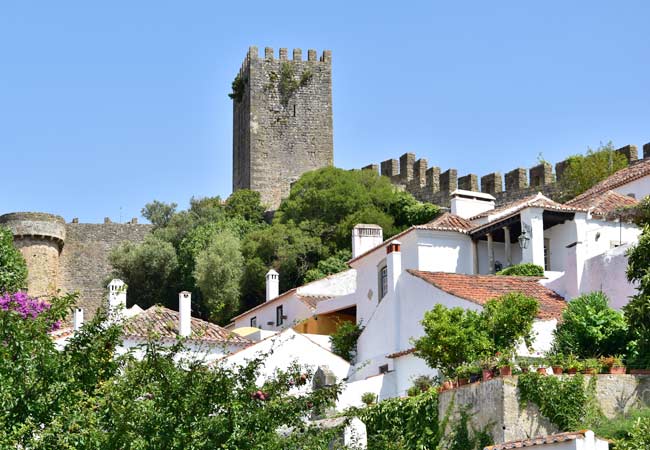
Nazaré - Where daredevil surfers tackle 30-meter winter waves watched by spectators standing at the clifftop lighthouse. This traditional fishing village combines a spectacular coastline, authentic maritime culture and modern extreme surfing - Nazaré guide
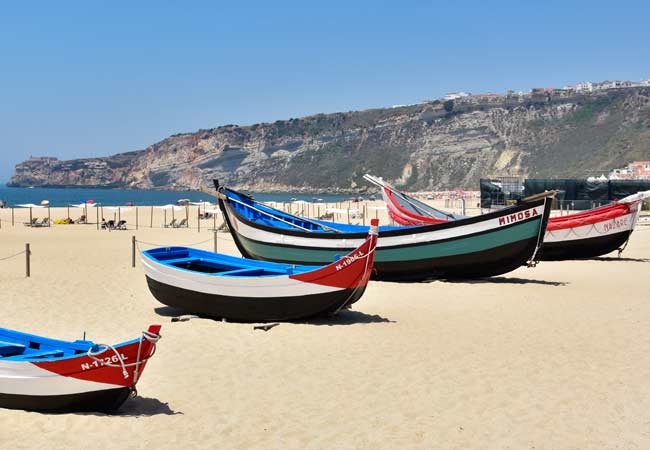
Aveiro - Cruise colourful canals on traditional moliceiro boats past Art Nouveau buildings. Known for its distinctive Ovos Moles sweets, Aveiro blends waterside charm with vibrant architecture and the unique landscape of its saltpans. - Aveiro guide
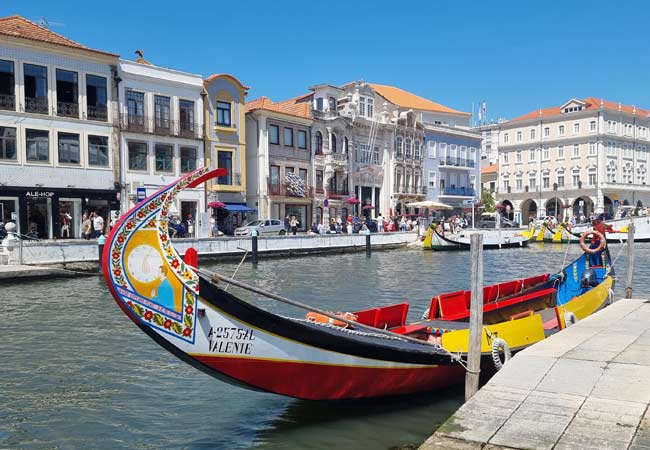
Berlengas Islands - Escape to this pristine archipelago nature reserve and setting of the 17th-century Fort of São João Baptista. The island offers secluded beaches, unique wildlife including rare seabirds, and some of Portugal's best snorkelling.
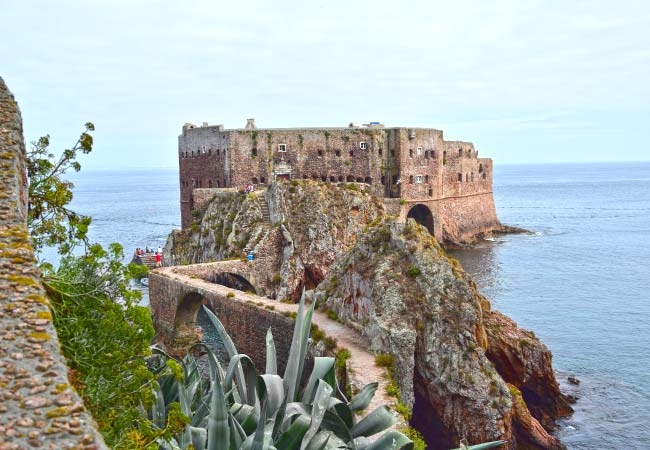
Batalha Monastery - Marvel at this Gothic masterpiece built to commemorate Portugal's victory at Aljubarrota. With its extraordinary Manueline-styled chapels, and imposing gothic styling it is regarded as one of Portugal's finest religious buildings.

Mira de Aire Caves - Descend into Portugal's largest cave system, plunging 110 meters underground through spectacular limestone formations.
Surfing – Huge Atlantic waves and vast sandy beaches, the draw for many to the Silver Coast is the fantastic surfing. Surfers often choose Peniche or Ericeira but there are a multitude of other locations.
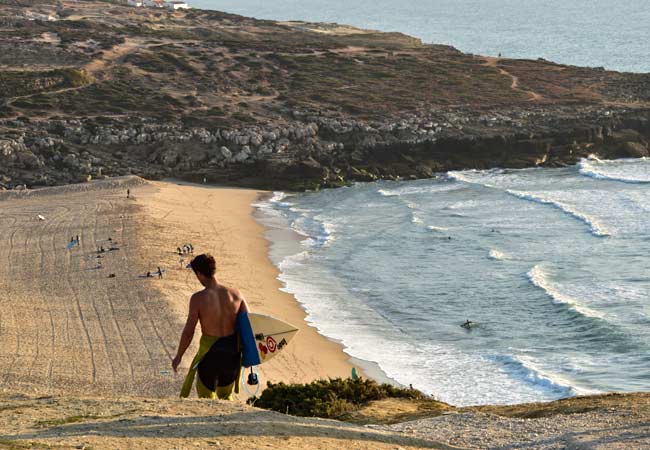
Note: The Silver Coast has no official definition on maps, with various interpretations of its boundaries. For this guide, we have focus on the core coastal region stretching roughly from Peniche to Aveiro. This means several noteworthy destinations have been excluded, including Coimbra, Tomar and Ericeira.
Hidden Gems of the Silver Coast
While Óbidos and Nazaré attract most visitors, the Silver Coast conceals many lesser-known treasures.
São Martinho do Porto sits on a shell-shaped bay which is sheltered from the powerful Atlantic waves by huge caves. This calm bay is ideal for families, has some of warmest sea waters of Portugal and is a popular holiday destion with the Portuguse.
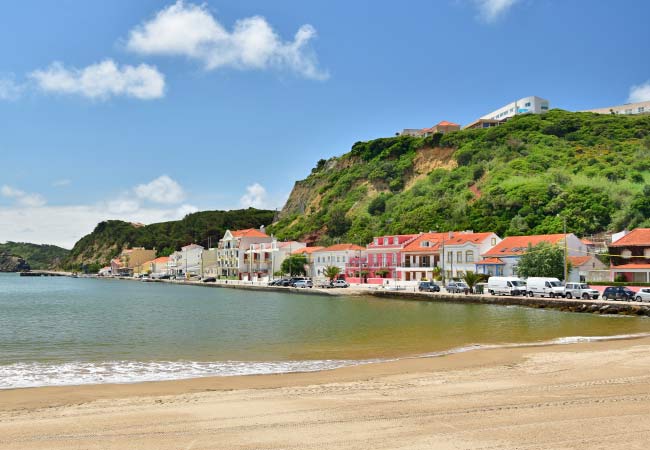
Nearby is Foz do Arelho a unique dual coastal setting where the Óbidos Lagoon meets the Atlantic, creating two distinct beach experiences side-by-side. On the southern side of Óbidos Lagoon is the Praia D'El Rey Golf course, one of the finest in the country.

Close to Figueira da Foz is the Serra da Boa Viagem offering forested hiking trails with panoramic coastal views stretching along the expansive beaches to Cabo Mondego's rugged cliffs. Further north is Costa Nova with its colourful striped fishermen's houses that are now Portugal's most photogenic villages.
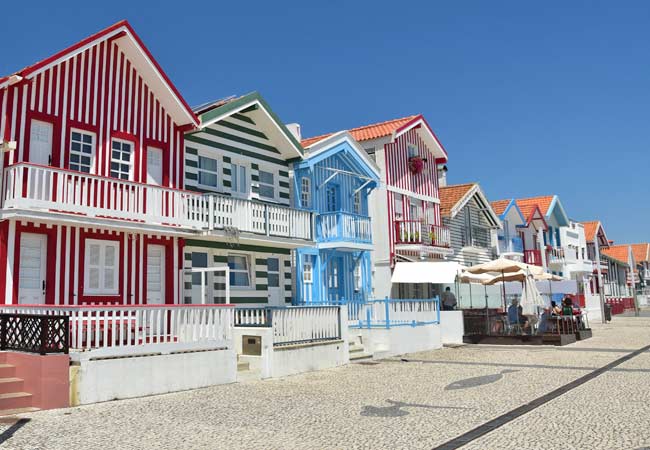
Among the coast's most surprising attractions is Buddha Eden-35 peaceful hectares of gardens filled with massive Buddha statues and terracotta warriors.

The limestone hills of Serra de Aire hide extensive networks of caves beyond the famous Mira de Aire Caves, including the Grutas da Moeda and Grutas de Santo António, while above land are fossil trails, and authentic villages largely untouched by tourism. Also there is Europe’s tallest tree close to Misarela.
The interactive map below shows the main towns of the Silver Coast along with its’ most famous tourist attractions. (Note: zoom in or out to see all of the points)
Towns: 1) Aveiro 2) Costa Nova 3) Coimbra 4) Figueira da Foz 5) Batalha 6) Nazaré 7) Alcobaça 8) São Martinho do Porto 9) Foz do Arelho 10) Caldas da Rainha 11) Óbidos 12) Peniche
Attractions and sights: 13) Berlengas Islands 14) Mira de Aire Caves 15) Serra da Boa Viagem 16) Grutas da Moeda 17) Buddha Eden 18) Fátima 19) Ourém Castle 20) Tomar 21) Ruínas de Conímbriga 22) Buçaco National Forest 23) Praia D'El Rey Golf
Where to Be Based in the Silver Coast
When exploring Portugal's Silver Coast, choosing the right location for your accommodation is an important consideration. Working from the north:
Aveiro and Costa Nova are typically visited as day trips from Porto or when travelling between Porto and Coimbra.
Coimbra makes the ideal base for the north section of the Silver Coast. From here there is easy access to Figueira da Foz, Buçaco National Forest, the schist villages and the Roman ruins of Conimbriga.
Tomar or Nazaré make great bases for the central area of the Silver Coast, and many of the best tourist sights lie directly between them. These include Alcobaça's monastery, Batalha's monastery, the pilgrimage site of Fátima, the Mira de Aire caves, medieval Ourém, and Tomar's magnificent Convento de Cristo.
For a quieter coastal experience, consider a few days in Foz do Arelho which provides a peaceful setting with its lagoon and oceanfront. If travelling with children and after beach town with less powerful waves or currents, consider São Martinho do Porto.
Though Peniche offers excellent surfing, it lacks the charm of other towns with its working fishing port ambiance and industrial surroundings. Óbidos, with its preserved medieval walls and whitewashed buildings, presents a more enchanting alternative.
In summary, your ideal base depends on which part of the Silver Coast you wish to explore: choose Óbidos for the southern section, Nazaré or Tomar for the central region, and Coimbra for northern areas.
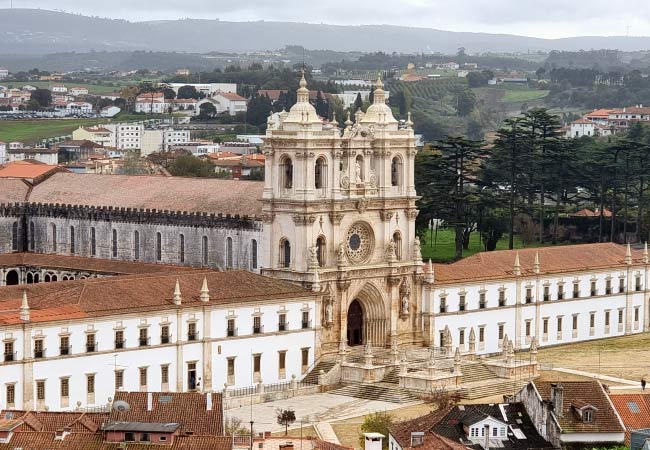
The Mosteiro de Alcobaça
Suggested Itineraries for the Silver Coast
Here is a recommended tour of the Silver Coast to get the most from the region. This route starts from Porto and ends in Lisbon, but it could be easily reversed.
Day 1: Aveiro & Costa Nova - Explore Aveiro's canals by moliceiro boat and visit its colourful Art Nouveau buildings. In the afternoon, visit Costa Nova's striped houses and relax on its beach.
Day 2: Coimbra - Visit the historic University of Coimbra, wander through the old town's narrow streets and visit Sé Velha Cathedral.
Day 2 Alternative: Enjoy Figueira da Foz's wide beaches and hike in nearby Serra da Boa Viagem forest.
Day 3: Nazaré - Spend a whole day in Nazaré, wander the Sítio headland and relax on the beach. If time permits, take a trip to Batalha.
Day 3 Alternative: Spend the day in historic Tomar with its magnificent Convento de Cristo.
Day 4: Nazaré to Óbidos - On the way to Óbidos, take stops at Alcobaça, Mira de Aire Caves or São Martinho do Porto and spend the night in charming Óbidos.
Day 5: Peniche & Berlengas - Explore Peniche in the morning and in the afternoon take a boat tour to the Berlengas Islands nature reserve.
Day 6: Ericeira and Mafra - Spend the morning in the charming fishing village and surf haven of Ericeira before visiting the magnificent Palácio Nacional de Mafra on the way to Lisbon.
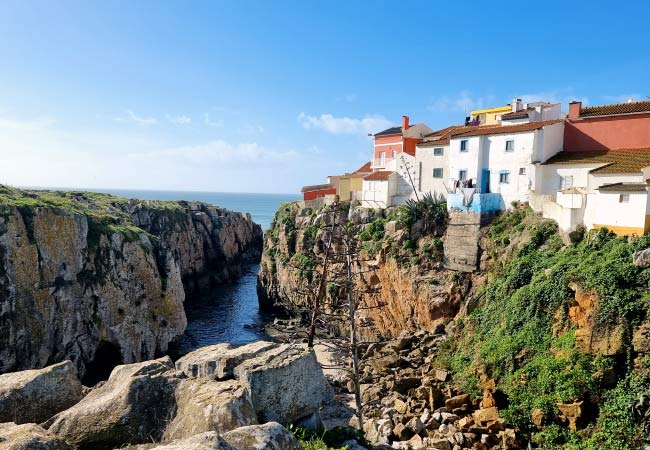
Weather of the Silver Coast
The Silver Coast enjoys a pleasant Mediterranean climate, but its weather is significantly moderated by the proximity of the Atlantic Ocean. This results in warm to hot summers and mild, though potentially wet winters.
The region boasts significant amounts of sunshine throughout the year, but travellers should expect more variability than in the Algarve, particularly regarding wind and winter rainfall.
Evenings can be cool year-round due to the ocean breeze, making layers advisable when packing. Summer temperatures typically range from 25-30°C (77-86°F), while winter daytime temperatures hover around 12-17°C (54-63°F), rarely dropping below freezing even at night.
The following weather charts are for Nazare. There can be significant variability between the coastal towns and the inland locations such as at Tomar or Coimbra it will feel much hotter during the summer
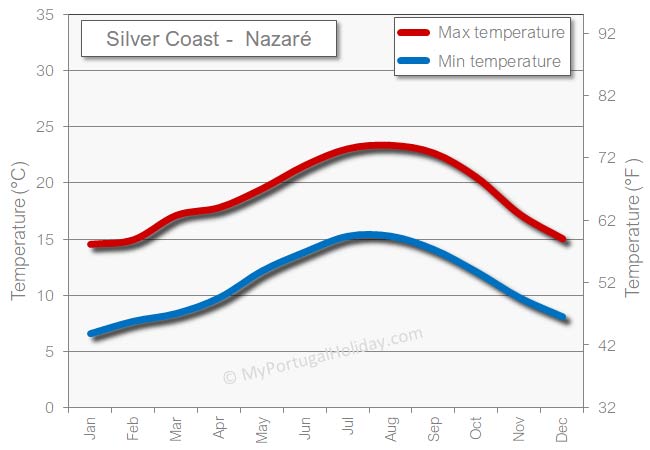
This is the average air temperature in the shade - in the sun it will feel much hotter!
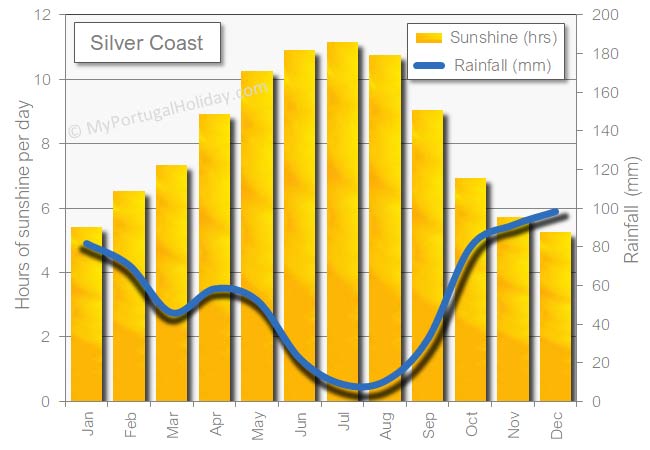
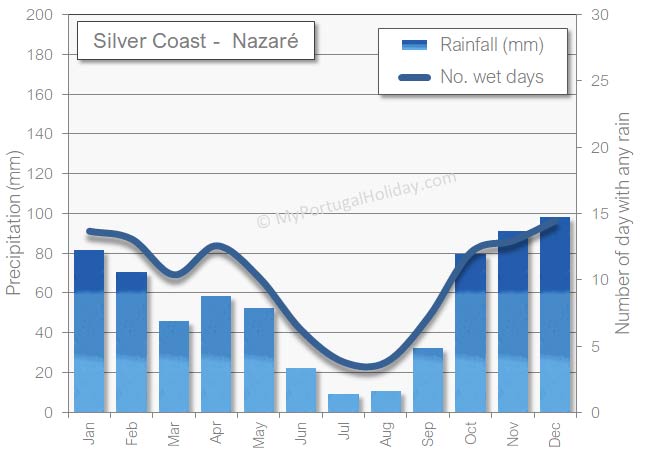
The Silver coast can have significant amounts of rain during the winter
Surfing at the Silver coast
The Silver Coast is a haven for surfers, offering a remarkable diversity of waves suitable for every skill level. Its exposed coastline catches Atlantic swells consistently throughout the year. Key hubs include Peniche, often dubbed the "surf capital," and Ericeira, the only World Surfing Reserve in Europe.
The Silver Coast offers world-class surfing beaches catering to all skill levels. Beginners should head to Peniche's Cantinho da Baia (Prainha), a sheltered spot next to Baleal peninsula with gentle, manageable waves. Nearby Areia Branca and Foz do Arelho also provide excellent learning conditions. In Ericeira, Foz do Lizandro and São Julião offer consistent, beginner-friendly waves over sand bottoms.
Intermediate surfers can progress to Lagide on Baleal's northern side with its quality left-hand waves, or the main Praia do Baleal which offers varying challenges depending on conditions. In Ericeira, the inside sections of Ribeira D'Ilhas provide good intermediate opportunities when the main peak isn't too powerful.
For advanced surfers, Peniche's famous Supertubos lives up to its "European Pipeline" nickname with fast, powerful barrels over sandbars that attract professional competitions. Ericeira boasts several world-class reef breaks including Ribeira D'Ilhas with its long, peeling right-handers and Coxos, considered one of Portugal's finest waves with its powerful, fast right-hand point break over a sharp reef.
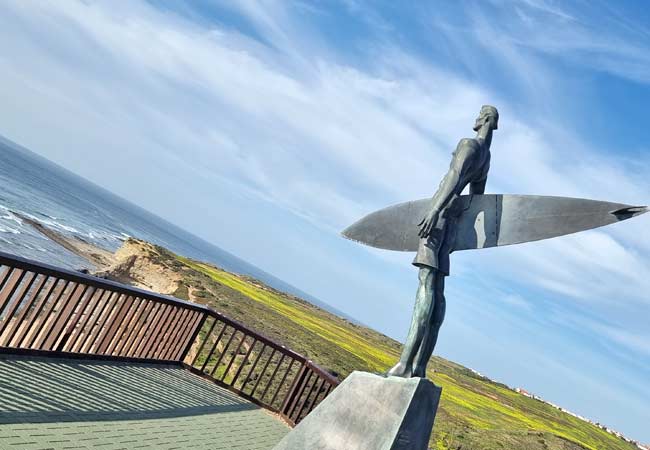
Why choose the Silver Coast over the Algarve?
For many first-time visitors planning a trip to Portugal's coast, the choice often comes down to the famous Algarve versus the less-known Silver Coast. While both regions offer beautiful beaches and a high quality of life, they present different experiences. The decision ultimately depends on what you're looking for in your trip.
The main appeal of the Silver Coast is its authenticity and fewer tourists. Visitors wanting to experience traditional Portuguese culture, away from crowds and tourist spots, will likely prefer the Silver Coast. Its relaxed pace of life, family-run businesses, and less built-up areas create a more peaceful and real experience. This authentic feel also means better prices, with both accommodation and daily costs usually lower than in popular Algarve towns.
The landscape is different too. While the Algarve is known for its golden beaches with distinctive cliffs, the Silver Coast has a wilder, more dramatic Atlantic shoreline, with green hills inland. Its location between Lisbon and Porto also makes it easier to visit Portugal's two biggest cities for cultural trips or to use their major airports.
On the other hand, the Algarve wins for weather, especially for those wanting winter sun, as it stays warmer and drier than the Silver Coast during the colder months.
Details of the Main Towns of the Silver Coast
Óbidos
Óbidos stands as one of Portugal's most picturesque and well-preserved medieval towns, entirely encircled by imposing 14th-century ramparts that offer spectacular views of terracotta rooftops and the surrounding countryside. Entering through the main gate (Porta da Vila), visitors step back centuries into a labyrinth of narrow, winding cobblestone streets lined with charming whitewashed houses adorned with colourful flowers and traditional blue trim.
The town is crowned by its magnificent castle, rebuilt by King Dinis I and now transformed into a luxurious pousada hotel. This architectural jewel completes the cheerful medieval ambiance that permeates the entire town. It should be noted that Óbidos is only small and can be fully seen within a couple hours of sightseeing.
Beyond its visual appeal, Óbidos delights visitors with its unique local specialty: Ginjinha de Óbidos. This sweet cherry liqueur, made from sour ginja berries, is traditionally served in small, edible dark chocolate cups-a perfect sensory complement to the visual feast of the town.
This harmonious blend of perfectly preserved medieval architecture, unique local traditions, vibrant seasonal festivals, and a deep literary heritage (celebrated in its bookshops and Literary Town status) makes Óbidos a truly captivating destination for any Silver Coast visitor.
Peniche
Peniche occupies a unique geographical position, situated on a rugged, windswept peninsula jutting out into the Atlantic Ocean. This geography defines its character, offering miles of coastline with diverse beaches on both its north and south shores, exposed to different swells and winds. The westernmost point, Cape Carvoeiro, is known for its dramatic limestone cliffs, lighthouse, and fascinating rock formations sculpted by the sea.

This exposure to the Atlantic has made Peniche Portugal's undisputed "surf capital". It offers a remarkable variety of surf breaks catering to all abilities, year-round. Beyond surfing, Peniche serves as the crucial gateway to the Berlengas Archipelago, a cluster of small, rocky islands located about 10km offshore. Designated a UNESCO Biosphere Reserve, the main island, Berlenga Grande, is a protected nature sanctuary. It's renowned for its crystal-clear turquoise waters, rich marine life and formidable 17th-century Fort of São João Baptista, perched precariously on a small islet connected by a narrow stone bridge.
Ferries operate from Peniche harbour, typically from March to October, but due to strict visitor limits (550 per day) and the requirement of a government "Berlengas Pass," advance booking is essential, especially during peak season.

Peniche remains an active fishing town with a bustling harbour, which is central to its identity and culinary scene. The daily catch ensures an abundance of incredibly fresh fish and seafood served in the town's many restaurants. Visiting the Peniche Fish Market offers an authentic glimpse into the local fishing culture.
This blend of raw natural beauty, world-class surf, rich maritime heritage, and poignant history gives Peniche a distinctly authentic, working-town character that appeals to travellers seeking experiences beyond typical tourist resorts.
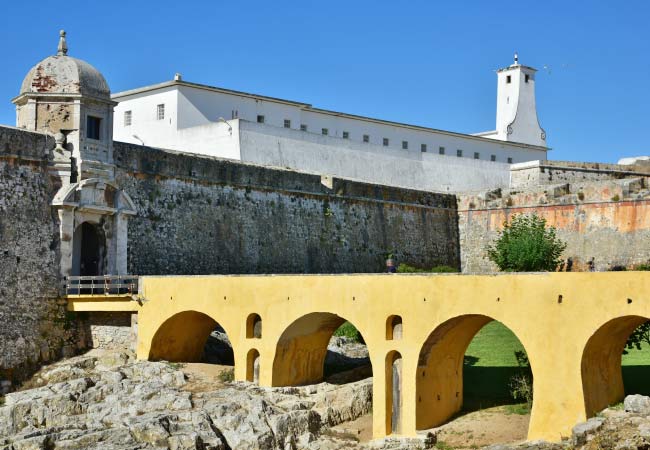
Nazaré
Nazaré presents a fascinating duality: it remains a deeply traditional fishing village while simultaneously holding the title of the world's most famous big wave surfing location. This blend of ancient maritime culture and modern extreme sport creates a unique and dynamic atmosphere.
The town's global fame rests on the monstrous waves generated at Praia do Norte, particularly between October and March. Fuelled by the immense underwater Nazaré Canyon, these waves regularly reach heights exceeding 30 meters (100 feet), attracting elite big-wave surfers from around the globe and resulting in numerous world records.
Sítio, the upper part of Nazaré reached by a steep funicular, provides breathtaking panoramic views over the main beach (Praia da Nazaré), the town, and the vast Atlantic. This historic area is also home to the Sanctuary of Our Lady of Nazaré and the small Ermida de Memória chapel, sites linked to a 12th-century miracle legend involving a nobleman saved from falling off the cliff edge.
Despite the international spotlight from surfing, Nazaré retains strong ties to its fishing heritage. Along the main beach promenade, visitors can still see the traditional practice of fish being laid out on racks to dry in the sun.
The town's fishing boats, traditionally painted in bright colours with high, curved prows reminiscent of Phoenician designs, add to the picturesque quality, though many are now moored in the modern harbour rather than hauled onto the beach. This mix of ancient traditions and the recent, explosive phenomenon of big wave surfing makes Nazaré a compelling stop on any Silver Coast itinerary.
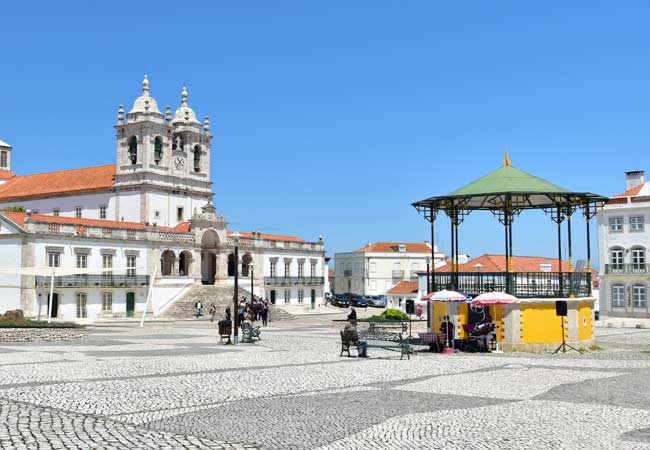
Aveiro
Aveiro possesses a unique charm, largely defined by its intricate network of canals that wind through the city. These waterways are navigated by colourful moliceiro boats, the city's most iconic symbol. The slender, high-prowed vessels were traditionally used for harvesting moliço (seaweed used as fertilizer) from the nearby Ria de Aveiro lagoon.
Today, they primarily serve as tourist boats, offering leisurely tours along the main canals like the Canal Central, Canal do Cojo, Canal das Pirâmides, and Canal de São Roque. The boats themselves are works of folk art, adorned with brightly painted panels on the bow and stern, often depicting historical scenes, religious motifs, local life, or sometimes humorous or risqué themes.

Aveiro is also distinguished as Portugal's "city-museum of Art Nouveau" with flowing lines, floral motifs, ornate ironwork. This style was bought to Aveiro by wealthy emigrants returning from Brazil who often applied decorative flourishes to their homes and frequently blended with traditional Portuguese azulejo tiles.
A short trip from Aveiro leads to Costa Nova, a coastal village instantly recognizable for its charming palheiros – traditional wooden houses painted in bold, vertical stripes of vibrant colours (red, blue, green, yellow) against a white background. Originally built as simple storage sheds and temporary shelters for fishermen, the distinctive stripes served a practical purpose: helping mariners identify their homes from the sea, particularly in the frequent coastal fog.

São Martinho do Porto
São Martinho do Porto stands out along the Silver Coast for its unique geography: a near-perfectly circular, shell-shaped bay connected to the Atlantic Ocean by only a narrow opening between rocky headlands. This natural configuration creates exceptionally calm and sheltered waters within the bay, a stark contrast to the often powerful waves found elsewhere along the Costa de Prata. This tranquillity makes São Martinho do Porto arguably the best beach destination on the Silver Coast for families with young children.
The calm, relatively warmer waters are ideal for safe swimming and paddling, and also popular for water sports like stand-up paddleboarding (SUP), kayaking, and sailing. During the summer months, a large inflatable water park is often set up in the bay, adding to the family fun. The beach itself is a wide crescent of fine, golden sand, perfect for relaxing and sunbathing.

Historically, São Martinho do Porto served as a sea port for the nearby town of Alcobaça and was involved in fishing and shipbuilding. However, from the late 19th century, it gained prominence as a fashionable seaside resort frequented by Portuguese nobility.
Many Portuguese families own holiday apartments here or have long-standing spots at the local campsites, creating an authentic Portuguese holiday atmosphere rather than one dominated by international tourism. Visitors can expect a lively, festive ambiance during the summer, with numerous reasonably priced restaurants serving traditional Portuguese food, alongside beach bars and cafes lining the pleasant promenade.
Caldas da Rainha
Caldas da Rainha, whose name translates to "Queen's Thermal Springs," owes its very existence and identity to its therapeutic waters and a royal encounter. Legend holds that in 1484, Queen Leonor, wife of King João II, witnessed locals bathing in steaming, muddy waters while traveling near Óbidos.
Learning of the waters' healing properties for aches and wounds, she tried them herself and was cured of an ailment. Consequently, she founded the Hospital Termal Rainha D. Leonor in 1485, recognised today as the oldest purpose-built thermal hospital in the world. This historic spa remains a central feature of the town, attracting visitors seeking wellness and relaxation in its sulphurous waters.
Parallel to its spa heritage, Caldas da Rainha developed into one of Portugal's most important centres for ceramic production, a tradition fuelled by the region's rich clay deposits. During the 19th century the town became famous for its naturalistic pieces, often depicting cabbage leaves, fish, fruit, and other elements of nature in vibrant glazes.
A vibrant slice of daily life unfolds at the Praça da Fruta (Fruit Square), home to Portugal's only daily open-air fruit and vegetable market. Operating continuously in the same location since the 15th century, this colourful market brings together local producers selling the freshest seasonal produce, flowers, cheeses, and local handicrafts.
Coimbra
Standing elegantly on the banks of the Mondego River, Coimbra resonates with history and youthful energy, primarily due to its celebrated university. The University of Coimbra, founded in 1290, is one of the oldest universities in continuous operation globally and the oldest in Portugal.
The university is not just a collection of buildings but the very soul of Coimbra. Its presence permeates the city, from the ancient Repúblicas (traditional communal student houses) scattered through the historic centre, to the vibrant student life that fills the streets and squares during term time. This academic pulse creates a unique duality: the city buzzes with energy during the week and academic year, then adopts a quieter, more tranquil air during weekends and holidays when many students return home.
Coimbra is famous for its deep-rooted academic traditions, including the distinctive student attire (black capes) and lively festivals like the Festa das Latas e Imposição de Insígnias.
Coimbra also boasts its own unique style of Fado music, distinct from the more commonly known Lisbon Fado. Fado de Coimbra is traditionally sung by male university students, often clad in their academic capes, and performed as a serenade, frequently in the streets or squares. Coimbra's unique fusion of ancient academic prestige, living traditions, stunning architecture, and youthful vibrancy makes it a deeply rewarding destination.
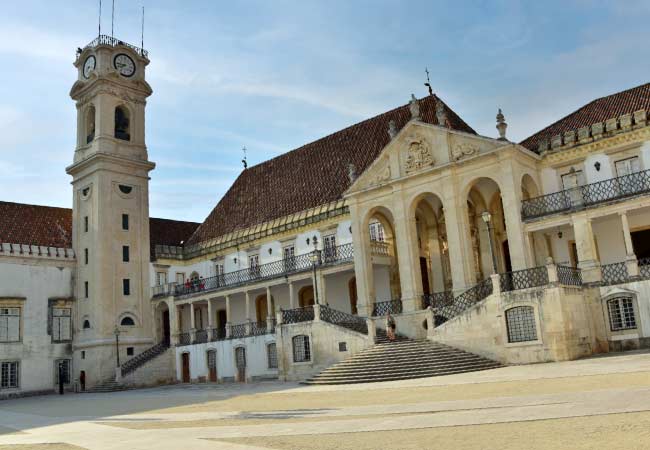
Coimbra university
Figueira da Foz
Figueira da Foz, situated at the broad mouth of the Mondego River, is often referred to as the "Queen of Portuguese Beaches".93 Its main claim to fame is the Praia da Claridade (Clarity Beach), an immense expanse of fine golden sand that is reputedly one of the widest urban beaches in Europe
Discover more of central Portugal with our guides
If you've found our content valuable, we'd welcome your support.
The digital publishing landscape has evolved significantly. As a small independent publisher, we face growing challenges. Search engines increasingly favour paid content over organic results, while AI-generated content often reproduces original work without attribution.
To support our work, please consider bookmarking this page (press Ctrl + D) for quick access. If you find an article helpful, we'd be grateful if you'd share it with friends on social media.
For specific questions, please see our Reddit community at r/LisbonPortugalTravel.
Should you notice any outdated or incorrect information, please contact us at [email protected]
Thank you for helping us continue to provide valuable content in an increasingly challenging digital environment.



























